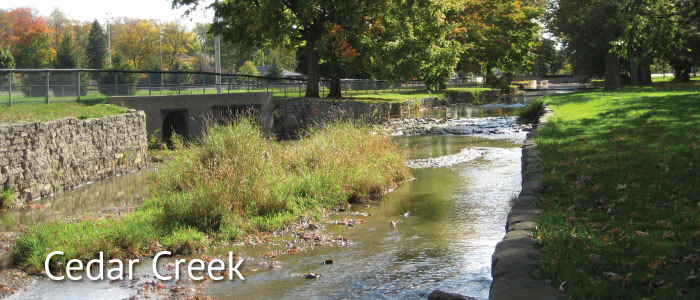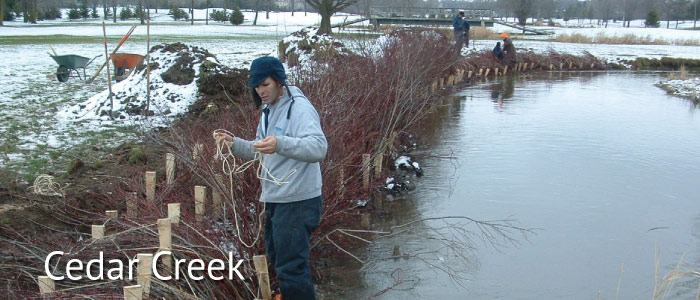Cedar Creek Watershed

The Cedar Creek watershed covers 95 square km, with land use comprised of 73% agriculture, 14% urban, and 12% forest. It is divided among three municipalities: 47% in Norwich Township, 35% in South-West Oxford, and 18% in the City of Woodstock, with a population of 20,340 (2011). The watershed is also home to 31 species of fish and four species of freshwater mussels.
Over the years, there has been local interest in enhancing Cedar Creek including the Cedar Creek Watershed Project, initiated in 1996 by the Woodstock Environmental Advisory Committee and the UTRCA. A Cedar Creek Watershed Management Strategy was developed in 1998 and a number of objectives of the plan were implemented with a focus on protecting groundwater in the headwater area.
The 2017 UTRCA Watershed Report Cards gave the Cedar Creek subwatershed a ‘D’ grade for surface water quality and a ‘D’ grade for forest conditions. These grades indicate that much work still needs to be done to improve the watershed’s environmental health. Recommendations included in the report suggest planting buffers along watercourses, protecting and enhancing the existing coldwater streams, mitigating the effects of barriers, reducing soil erosion, implementing agricultural BMPs, increasing forest interior, increasing biodiversity, and increasing the connectivity of woodlots through corridors.
The City of Woodstock was very concerned with the low grade in the 2007 report cards and commissioned the Cedar Creek Water Quality Study (2009). Some of the study’s recommendations include:
- Broad scale pollution reduction initiatives.
- Pollution awareness program, such as Yellow Fish Road, in Woodstock to educate residents about harmful effects.
- Encourage the adoption of rural BMPs.
- Protect and enhance the relatively natural sections of Cedar Creek and its riparian zone. Reaches that have seriously degraded habitat should be improved.
- Mitigating barrier impacts and preserving and enhancing stream and riparian habitat would greatly benefit Cedar Creek’s fish community.
- Potential remedies to the effects of barriers/dams currently in Cedar Creek include barrier removal and stream channel restoration, or retention of the ponds and creation of bypass channels.
- Re-establish a local action group called the Friends of Cedar Creek. A community action group could be one approach to implementing some of the awareness and implementation activities in the watershed.
The City of Woodstock is already acting on these recommendations. An Environmental Assessment for Southside Pond began in 2011 and concluded in late 2012. Part of its scope was to assess the impacts of Southside Pond on Cedar Creek water quality. If implemented, the recommended actions from the EA should have a significant positive impact on Cedar Creek water quality.

Cedar Creek Watershed Strategy
In 2011 a Cedar Creek Collaborative formed consisting of the Upper Thames River Conservation Authority, City of Woodstock, Townships of Norwich and South-West Oxford, and the Oxford County Trails Council. The goal was to develop a long-term, community-driven strategy to improve the environmental conditions of the Cedar Creek watershed. The Cedar Creek Watershed Strategy project officially began in spring 2012 and concluded in spring 2013, with funding from the Ontario Trillium Foundation.
For More Information
Contact Brad Hertner, Community Partnership Specialist (+1 (519) 451-2800 ext. 274)

